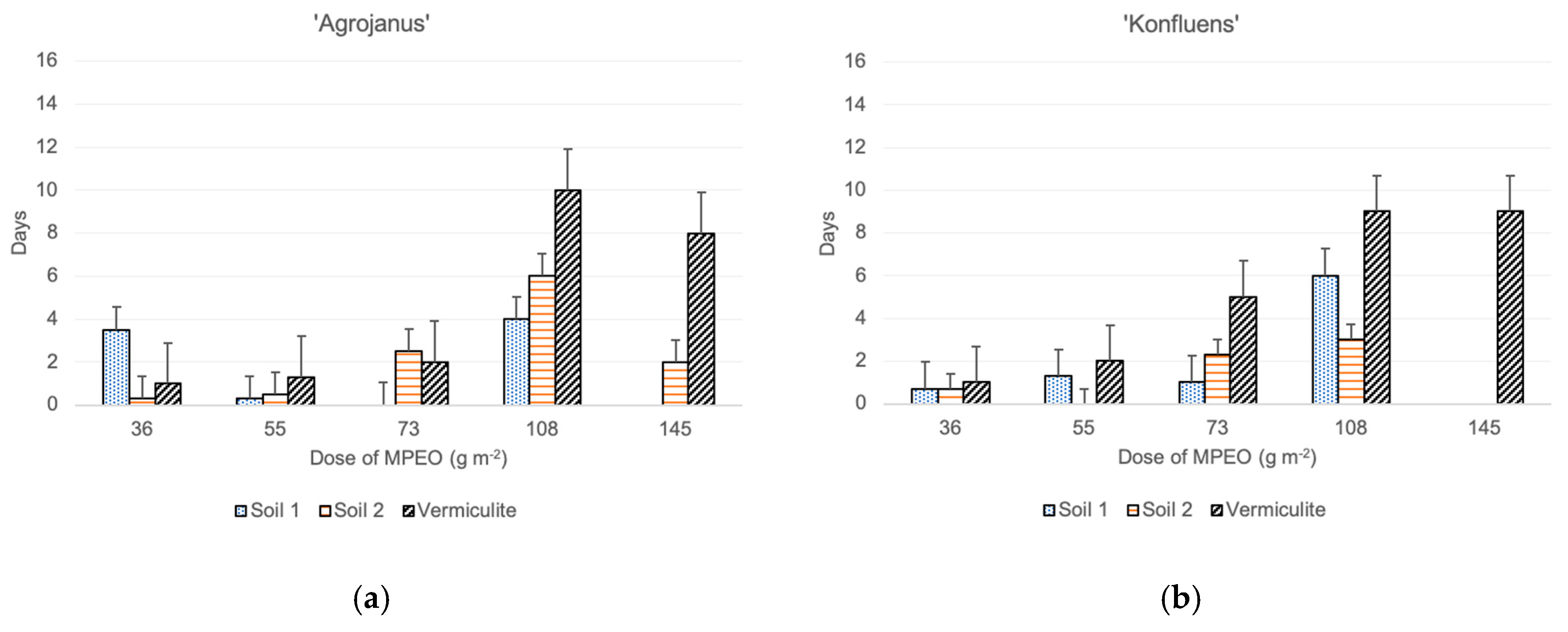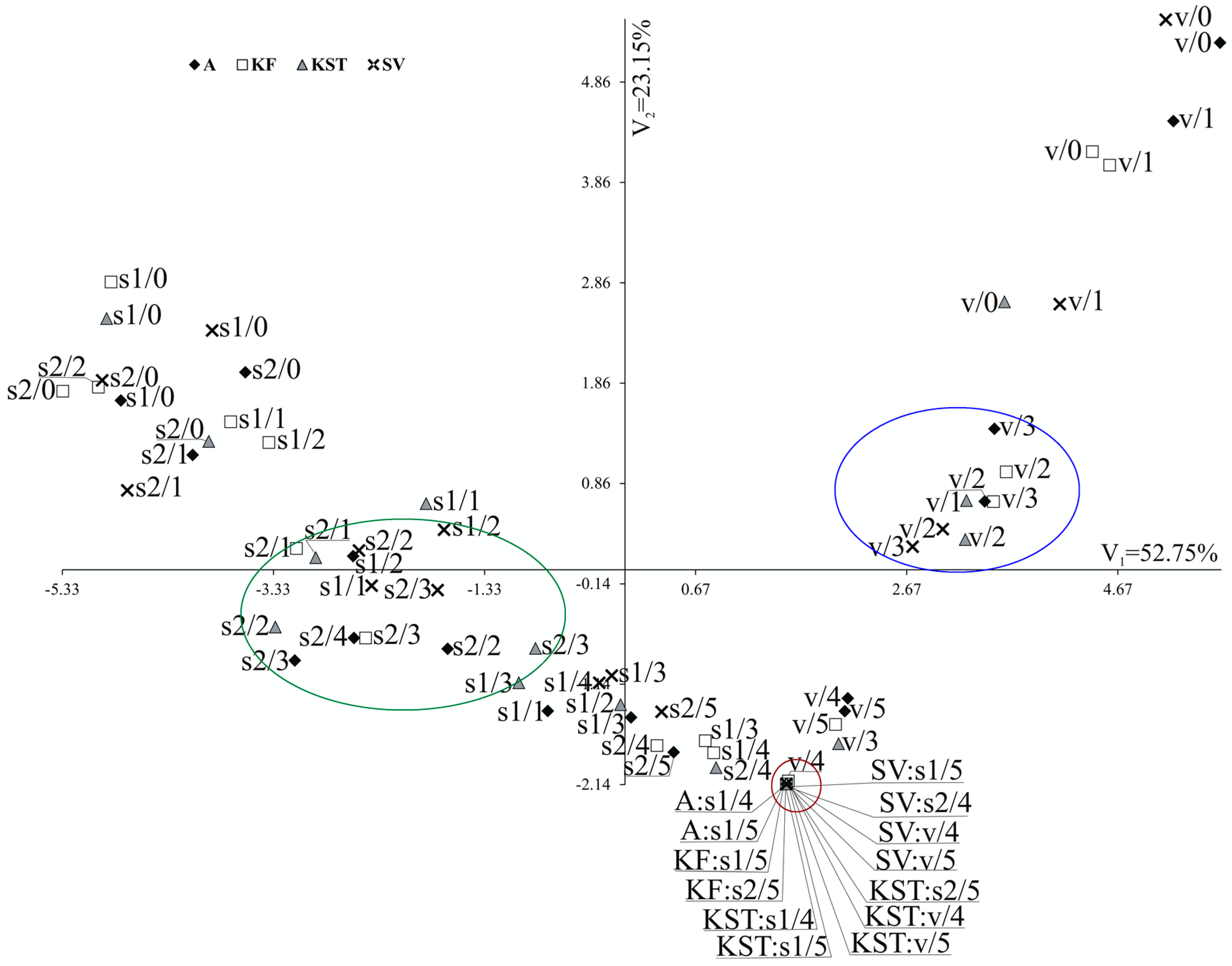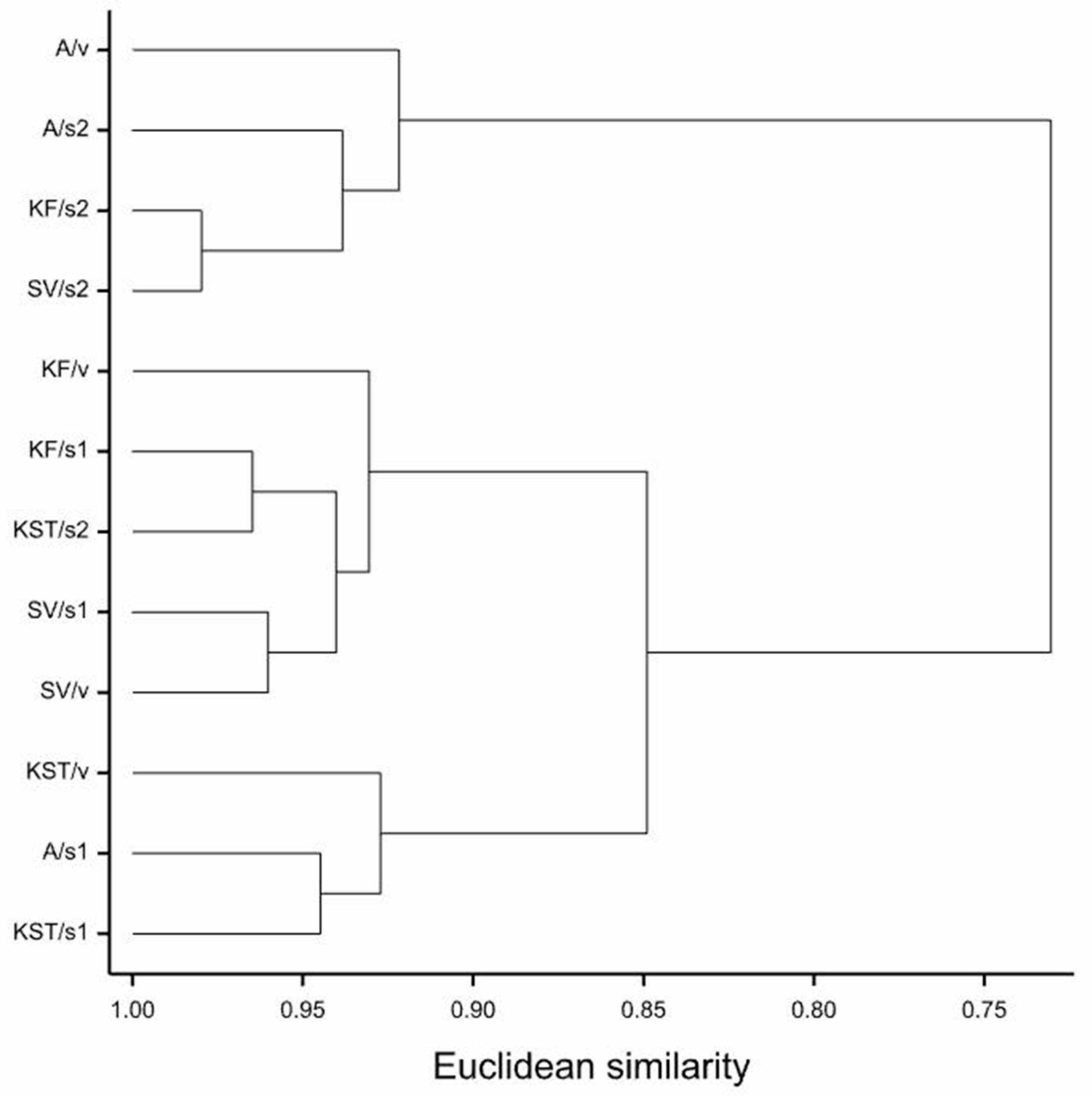The Phytotoxicity of Microencapsulated Peppermint Oil on Maize (Zea mays L.) Depending on the Type of Growth Substrate and Maize Cultivar
Abstract
:1. Introduction
2. Materials and Methods
2.1. Characteristics of Microencapsulated Peppermint Essential Oil
2.2. Description of the Pot Experiments
- (1)
- Vermiculite (GRANUTEC ® E. www.cmmp.fr). The medium and small-sized vermiculite, 1–3 mm and 3–6 mm, respectively, were mixed in a proportion of 1:1 (v/v);
- (2)
- Soil 1, collected from a conventional field with winter wheat at La Boissière-École (48°69′29.11″ N, 1°64′84.74″ E);
- (3)
- Soil 2, collected from the organic field with winter wheat at the Agricultural College de Chartres—La Saussaye (48°40′41.3″ N, 1°55′58.71″ E).
2.3. Maize Measurements
2.4. Statistical Analysis
3. Results
3.1. Chemical Composition of Peppermint Oil in the Microcapsules
3.2. The Effect of MPEO on Emergence of Maize
3.3. The Effect of Substrates and Doses of MPEO on Maize Growth
4. Discussion
Supplementary Materials
Author Contributions
Funding
Acknowledgments
Conflicts of Interest
References
- Ibáñez, M.D.; Blázquez, M.A. Phytotoxicity of essential oils on selected weeds: Potential hazard on food crops. Plants 2018, 7, 79. [Google Scholar] [CrossRef] [PubMed] [Green Version]
- Smeriglio, A.; Trombetta, D.; Cornara, L.; Valussi, M.; De Feo, V.; Caputo, L. Characterization and phytotoxicity assessment of essential oils from plant byproducts. Molecules 2019, 24, 2941. [Google Scholar] [CrossRef] [PubMed] [Green Version]
- Synowiec, A.; Kalemba, D.; Drozdek, E.; Bocianowski, J. Phytotoxic potential of essential oils from temperate climate plants against the germination of selected weeds and crops. J. Pest Sci. 2017, 90, 407–419. [Google Scholar] [CrossRef]
- Hashem, A.S.; Awadalla, S.S.; Zayed, G.M.; Maggi, F.; Benelli, G. Pimpinella anisum essential oil nanoemulsions against Tribolium castaneum—Insecticidal activity and mode of action. Environ. Sci. Pollut. Res. 2018, 25, 18802–18812. [Google Scholar] [CrossRef]
- Dayan, F.E. Is there a natural route to the next generation of herbicides? Outlooks Pest Manag. 2018, 29, 54–57. [Google Scholar] [CrossRef]
- Karamanoli, K.; Ainalidou, A.; Bouzoukla, F.; Vokou, D. Decomposition profiles of leaf essential oils in the soil environment. Ind. Crops Prod. 2018, 124, 397–401. [Google Scholar] [CrossRef]
- Synowiec, A.; Lenart-Boroń, A.; Bocianowski, J.; Lepiarczyk, A.; Kalemba, D. How Soil-Applied Maltodextrin with Caraway (Carum carvi L.) Oil Affects Weed and Soil Microbiological Activity in Maize (Zea mays L.) Stands. Pol. J. Environ. Stud. 2020, 29, 817–826. [Google Scholar] [CrossRef]
- Kalemba, D.; Synowiec, A. Agrobiological Interactions of Essential Oils of Two Menthol Mints: Mentha piperita and Mentha arvensis. Molecules 2019, 25, 59. [Google Scholar] [CrossRef] [Green Version]
- Chalchat, J.-C.; Garry, R.-P.; Michet, A. Variation of the Chemical Composition of Essential Oil of Mentha piperita L. during the Growing Time. J. Essent. Oil Res. 1997, 9, 463–465. [Google Scholar] [CrossRef]
- Sarkic, A.; Stappen, I. Essential oils and their single compounds in cosmetics—A critical review. Cosmetics 2018, 5, 11. [Google Scholar] [CrossRef] [Green Version]
- Oroian, C.; Covrig, I.; Odagiu, A.; Mălinaș, C.; Moldovan, C.; Fleșeriu, A. Effects of cultivation systems and environmental conditions on peppermint (Mentha × piperita L.) biomass yield and oil content. Notulae Bot. Horti Agrobot. Cluj Napoca 2017, 45, 576–581. [Google Scholar] [CrossRef]
- Ostadi, A.; Javanmard, A.; Machiani, M.A.; Morshedloo, M.R.; Nouraein, M.; Rasouli, F.; Maggi, F. Effect of different fertilizer sources and harvesting time on the growth characteristics, nutrient uptakes, essential oil productivity and composition of Mentha × piperita L. Ind. Crops Prod. 2020, 148, 112290. [Google Scholar] [CrossRef]
- Maes, C.; Bouquillon, S.; Fauconnier, M.-L. Encapsulation of Essential Oils for the Development of Biosourced Pesticides with Controlled Release: A Review. Molecules 2019, 24, 2539. [Google Scholar] [CrossRef] [PubMed] [Green Version]
- Gorena, R.T.; Romero, N.; Sepulveda, E.; Chavez, J.; Saenz, C. Encapsulation of polyphenols and anthocyanins from pomegranate (Punica granatum) by spray drying. Int. J. Food Sci. Technol. 2010, 45, 1386. [Google Scholar]
- Adamiec, J.; Kalemba, D. Analysis of microencapsulation ability of essential oils during spray drying. Drying Technol. 2006, 24, 1127–1132. [Google Scholar] [CrossRef]
- Synowiec, A.; Smęda, A.; Adamiec, J.; Kalemba, D. The effect of microencapsulated essential oils on the initial growth of maize (Zea mays) and common weeds (Echinochloa crus-galli and Chenopodium album). Prog. Plant Prot. 2016, 56, 372–378. [Google Scholar]
- Synowiec, A.; Możdżeń, K.; Krajewska, A.; Landi, M.; Araniti, F. Carum carvi L. essential oil: A promising candidate for botanical herbicide against Echinochloa crus-galli (L.) P. Beauv. in maize cultivation. Ind. Crops Prod. 2019, 140, 111652. [Google Scholar] [CrossRef]
- Karkanis, A.; Alexiou, A.; Katsaros, C.; Petropoulos, S. Allelopathic Activity of Spearmint (Mentha spicata L.) and Peppermint (Mentha × piperita L.) Reduces Yield, Growth, and Photosynthetic Rate in a Succeeding Crop of Maize (Zea mays L.). Agronomy 2019, 9, 461. [Google Scholar] [CrossRef] [Green Version]
- Synowiec, A.; Krajewska, A. Soil or Vermiculite-Applied Microencapsulated Peppermint Oil Effects on White Mustard Initial Growth and Performance. Plants 2020, 9, 448. [Google Scholar] [CrossRef] [Green Version]
- Carlile, W.; Cattivello, C.; Zaccheo, P. Organic Growing Media: Constituents and Properties. Vadose Zone J. 2015, 14, 1–13. [Google Scholar] [CrossRef] [Green Version]
- Adams, R.P. Identification of Essential Oil Components by Gas Chromatography/Mass Spectrometry, 4th ed.; Allured Publishing Corporation: Carol Stream, IL, USA, 2007. [Google Scholar]
- Jumrani, K.; Bhatia, V.S.; Pandey, G.P. Impact of elevated temperatures on specific leaf weight, stomatal density, photosynthesis and chlorophyll fluorescence in soybean. Photosynth. Res. 2017, 131, 333–350. [Google Scholar] [CrossRef]
- Singleton, V.L. Colorimetry of total phenolics with phosphomolybdic phosphotungstic acid reagents. Am. J. Enol. Vitic. 1965, 16, 144–158. [Google Scholar]
- Yap, B.W.; Sim, C.H. Comparisons of various types of normality tests. J. Stat. Comput. Simulat. 2011, 81, 2141–2155. [Google Scholar] [CrossRef]
- Rencher, A.C. Interpretation of canonical discriminant functions, canonical variates, and principal components. Am. Statist. 1992, 46, 217–225. [Google Scholar]
- Bocianowski, J.; Majchrzak, L. Analysis of effects of cover crop and tillage method combinations on the phenotypic traits of spring wheat (Triticum aestivum L.) using multivariate methods. Appl. Ecol. Environ. Res. 2019, 17, 15267–15276. [Google Scholar] [CrossRef]
- De Maesschalck, R.; Jouan-Rimbaud, D.; Massart, D.L. The Mahalanobis distance. Chemom. Intell. Lab. Syst. 2000, 50, 1–18. [Google Scholar] [CrossRef]
- Seidler-Łożykowska, K.; Bocianowski, J. Evaluation of variability of morphological traits of selected caraway (Carum carvi L.) genotypes. Ind. Crops Prod. 2012, 35, 140–145. [Google Scholar] [CrossRef]
- Camussi, A.; Ottaviano, E.; Calinski, T.; Kaczmarek, Z. Genetic distances based on quantitative traits. Genetics 1985, 111, 945–962. [Google Scholar]
- Ritz, C.; Baty, F.; Streibig, J.C.; Gerhard, D. Dose-Response Analysis Using R. PLoS ONE 2015, 10, e0146021. [Google Scholar] [CrossRef] [Green Version]
- Council of Europe. European Pharmacopoeia 7.0; Council of Europe: Strasbourg, France, 2010. [Google Scholar]
- Synowiec, A.; Halecki, W.; Wielgusz, K.; Byczyńska, M.; Czaplicki, S. Effect of Fatty Acid Methyl Esters on the Herbicidal Effect of Essential Oils on Corn and Weeds. Weed Technol. 2017, 31, 301–309. [Google Scholar] [CrossRef]
- Mhlanga, B.; Chauhan, B.S.; Thierfelder, C. Weed management in maize using crop competition: A review. Crop Prot. 2016, 88, 28–36. [Google Scholar] [CrossRef]
- Knezevic, S.Z.; Evans, S.P.; Mainz, M. Yield penalty due to delayed weed control in corn and soybean. Crop Manag. 2003, 2, 1–7. [Google Scholar] [CrossRef] [Green Version]
- Williams, M.M.; Lindquist, J.L. Influence of planting date and weed interference on sweet corn growth and development. Agron. J. 2007, 99, 1066–1072. [Google Scholar] [CrossRef] [Green Version]
- Tursun, N.; Datta, A.; Sakinmaz, M.S.; Kantarci, Z.; Knezevic, S.Z.; Chauhan, B.S. The critical period for weed control in three corn (Zea mays L.) types. Crop Prot. 2016, 90, 59–65. [Google Scholar] [CrossRef]
- Barros, R.E.; Faria, R.M.; Tuffi Santos, L.D.; Azevedo, A.M.; Governici, J.L. Physiological Response of Maize and Weeds in Coexistence. Planta Daninha 2017, 35, 1–8. [Google Scholar] [CrossRef] [Green Version]
- Rama, M.; Laiho, T.; Eklund, O.; Wärnå, J. An evaluation of the capability of nanomodified vermiculite to in situ ammonium removal from landfill leachate. Environ. Technol. Innovat. 2019, 14, 100340. [Google Scholar] [CrossRef]
- Tsuda, S.; Miyamoto, N.; Takahashi, H.; Ishihara, K.; Hirasawa, T. Roots of Pisum sativum L. exhibit hydrotropism in response to a water potential gradient in vermiculite. Ann. Bot. 2003, 92, 767–770. [Google Scholar] [CrossRef] [Green Version]
- Gairola, K.C.; Nautiyal, A.R.; Dwivedi, A.K. Effect of temperatures and germination media on seed germination of Jatropha curcas Linn. Adv. Biores. 2011, 2, 66–71. [Google Scholar]
- Drury, C.F.; Tan, C.S.; Welacky, T.W.; Oloya, T.O.; Hamill, A.S.; Weaver, S.E. Red clover and tillage influence on soil temperature, water content, and corn emergence. Agron. J. 1999, 91, 101–108. [Google Scholar] [CrossRef]
- Seebauer, J.R.; Below, F.E. Use of in vitro kernel culture to study maize nitrogen and carbohydrate metabolism. In Maize; Humana Press: New York, NY, USA, 2018; pp. 3–13. [Google Scholar]
- Kısa, D.; Elmastaş, M.; Öztürk, L.; Kayır, Ö. Responses of the phenolic compounds of Zea mays under heavy metal stress. Appl. Biol. Chem. 2016, 59, 813–820. [Google Scholar] [CrossRef]
- Malčovská, S.M.; Dučaiová, Z.; Maslaňáková, I.; Bačkor, M. Effect of silicon on growth, photosynthesis, oxidative status and phenolic compounds of maize (Zea mays L.) grown in cadmium excess. Water Air Soil Pollut. 2014, 225, 2056. [Google Scholar] [CrossRef]
- Sakihama, Y.; Cohen, M.F.; Grace, S.C.; Yamasaki, H. Plant phenolic antioxidant and prooxidant activities: Phenolics-induced oxidative damage mediated by metals in plants. Toxicology 2002, 177, 67–80. [Google Scholar] [CrossRef]
- Singh, H.P.; Kaur, S.; Mittal, S.; Batish, D.R.; Kohli, R.K. Essential oil of Artemisia scoparia inhibits plant growth by generating reactive oxygen species and causing oxidative damage. J. Chem. Ecol. 2009, 35, 154–162. [Google Scholar] [CrossRef] [PubMed]





| Sand | Clay | Silt | Corg | P2O5 | K2O | MgO | Ntotal | pH | |
|---|---|---|---|---|---|---|---|---|---|
| (%) | (%) | (%) | (g kg−1) | (mg kg−1) | (mg kg−1) | (mg kg−1) | (g kg−1) | ||
| Soil 1 | 56 | 8.9 | 35.1 | 11.8 | 82 | 193 | 99 | 1.09 | 6.57 |
| Soil 2 | 5.2 | 31.3 | 63.5 | 12.7 | 86 | 270 | 117 | 1.38 | 7.93 |
| Compound | EP [%] 1 | RI Lit 2 | RI Exp 3 | RT 4 | Average [%] |
|---|---|---|---|---|---|
| α-Pienen | 934 | 930 | 11.79 | 0.4 | |
| Sabinene | 970 | 13.25 | 0.1 | ||
| β-Pinene | 974 | 969 | 13.34 | 0.6 | |
| 1.8-Cineol | 3.5–14.0 | 1024 | 1017 | 15.38 | 4.2 |
| Limonene | 1025 | 1021 | 15.48 | 0.6 | |
| Limonene Oxide | 0.1–5.0 | - | |||
| Menthone | 14.0–32.0 | 1139 | 1134 | 20.14 | 20.6 |
| Isomenthone | 1.5–10.0 | 1046 | 1142 | 20.40 | 3.7 |
| Menthofuran | 0.1–0.9 | 1050 | t 5 | ||
| Neomenthol | 1155 | 1150 | 20.71 | 2.5 | |
| Menthol | 30.0–55.0 | 1163 | 1166 | 21.40 | 60.1 |
| Neoisomenthol | 1171 | 1170 | 21.52 | 0.4 | |
| Isomenthol | 1176 | 1176 | 21.73 | 0.2 | |
| Pulegone | <4.0 | 1218 | 1215 | 23.34 | 0.2 |
| Piperitone | 1232 | 1233 | 23.81 | 0.2 | |
| Menthyl Acetate | 1280 | 1275 | 25.56 | 4.0 | |
| Bicycloelemene | 1338 | 1328 | 27.51 | 0.1 | |
| β-Bourbonene | 1386 | 1378 | 29.27 | 0.1 | |
| (E)-β-Caryophyllene | 1421 | 1410 | 30.40 | 0.4 | |
| ε-Muurolene | 1455 | 1445 | 31.48 | 0.1 | |
| Caryophyllene Oxide | 1573 | 1568 | 35.40 | 0.9 | |
| Total identified | 99.33 |
| Cultivar 2 | Length (cm) | Dry Weight (g) | Second Leaf | |||
|---|---|---|---|---|---|---|
| Shoot | Root | Shoot | Root | Specific Weigth (mg) | Area (cm2) | |
| Vermiculite | ||||||
| A | 80.5 ± 11.3 | 85.1 ± 16.6 | 55.5 ± 5.7 | 60.6 ± 57.8 | 90.3 ± 11.2 | 60.8 ± 6.2 |
| KF | 75.3 ± 11.1 | 62.5 ± 9.3 | 58.2 ± 7.0 | 40.9 ± 4.5 | 74.3 ± 11.6 | 73.0 ± 12.8 |
| KST | 61.2 ± 5.0 | 56.8 ± 4.5 | 48.6 ± 10.1 | 16.5 ± 60.0 | 57.5 ± 11.2 | 61.7 ± 6.0 |
| SV | 63.6 ± 7.0 | 79.9 ± 11.9 | 45.7 ± 6.0 | 35.3 ± 4.3 | 69.0 ± 10.0 | 48.7 ± 4.8 |
| Soil 1 | ||||||
| A | 49.0 ± 14.13 | 48.4 ± 16.60 | 19.9 ± 11.90 | 11.5 ± 10.46 | 48.7 ± 15.87 | 71.7 ± 7.46 |
| KF | 61.8 ± 1.81 | 64.0 ± 3.51 | 59.4 ± 1.82 | 59.3 ± 2.94 | 63.1 ± 1.80 | 67.6 ± 3.45 |
| KST | 51.2 ± 6.31 | 44.9 ± 4.03 | 38.7 ± 3.82 | 29.9 ± 4.63 | 36.8 ± 5.46 | 54.5 ± 7.31 |
| SV | 72.1 ± 12.90 | 67.0 ± 11.34 | 41.5 ± 11.38 | 45.6 ± 12.34 | 57.7 ± 8.90 | 74.1 ± 12.33 |
| Soil 2 | ||||||
| A | 86.5 ± 22.77 | 75.3 ± 16.71 | 57.7 ± 9.62 | 64.1 ± 12.71 | 95.7 ± 26.18 | 111.0 ± 35.41 |
| KF | 81.6 ± 3.46 | 79.1 ± 5.41 | 72.6 ± 2.01 | 72.3 ± 3.85 | 74.3 ± 9.15 | 94.8 ± 5.49 |
| KST | 55.4 ± 7.12 | 67.2 ± 8.49 | 43.2 ± 8.25 | 44.5 ± 8.99 | 55.2 ± 8.57 | 63.1 ± 8.19 |
| SV | 82.0 ± 8.29 | 78.9 ± 8.80 | 63.5 ± 7.71 | 58.3 ± 6.22 | 66.9 ± 5.16 | 84.2 ± 12.91 |
© 2020 by the authors. Licensee MDPI, Basel, Switzerland. This article is an open access article distributed under the terms and conditions of the Creative Commons Attribution (CC BY) license (http://creativecommons.org/licenses/by/4.0/).
Share and Cite
Synowiec, A.; Bocianowski, J.; Krajewska, A. The Phytotoxicity of Microencapsulated Peppermint Oil on Maize (Zea mays L.) Depending on the Type of Growth Substrate and Maize Cultivar. Agronomy 2020, 10, 1302. https://doi.org/10.3390/agronomy10091302
Synowiec A, Bocianowski J, Krajewska A. The Phytotoxicity of Microencapsulated Peppermint Oil on Maize (Zea mays L.) Depending on the Type of Growth Substrate and Maize Cultivar. Agronomy. 2020; 10(9):1302. https://doi.org/10.3390/agronomy10091302
Chicago/Turabian StyleSynowiec, Agnieszka, Jan Bocianowski, and Agnieszka Krajewska. 2020. "The Phytotoxicity of Microencapsulated Peppermint Oil on Maize (Zea mays L.) Depending on the Type of Growth Substrate and Maize Cultivar" Agronomy 10, no. 9: 1302. https://doi.org/10.3390/agronomy10091302






